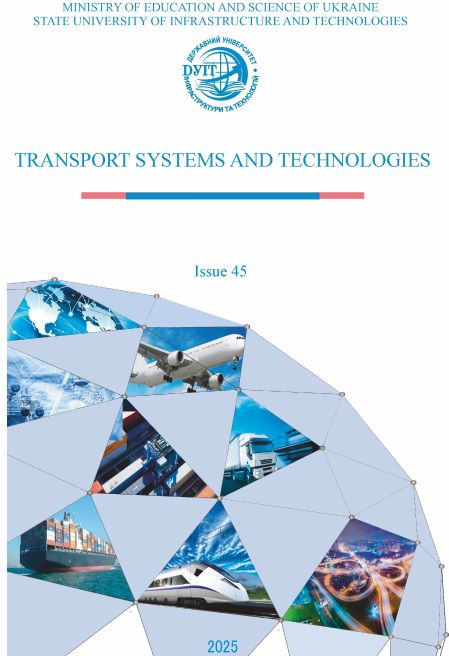Research of theoretical basis of implementation of intelligent control systems for locomotive traction transmission
Keywords:
railway transport, rolling stock, control, artificial intelligence, Mamdani method, risk, traction electric transmission, safetyAbstract
The paper presents an analysis of existing automated control systems based on artificial intelligence theory. These systems employ methods such as fuzzy logic, artificial neural networks, and genetic algorithms. The application of these techniques enables the development of more adaptive and efficient control systems compared to traditional approaches. The main areas of artificial intelligence application in railway transport are identified, particularly in locomotive control systems and optimization of operational modes. The fundamental stages of artificial intelligence-based model development are outlined, including data collection and model training. Key directions for modeling intelligent systems are established. A generalized approach is proposed for the development of an intelligent traction transmission control system for shunting locomotives, taking into account the rolling stock characteristics and operational conditions. For solving control tasks, the use of a production model is proposed, which integrates elements of both logical and network-based approaches. A production model is proposed for solving control tasks.
References
Fernández, P. M., Sanchís, I. V., Yepes, V., & Franco, R. I. (2019). A review of modelling and optimisation methods applied to railways energy consumption. Journal of Cleaner Production, 222, 153-162. https://doi.org/10.1016/j.jclepro.2019.03.037.
Aredah, A., Du, J., Hegazi, M., List, G., & Rakha, H. A. (2024). Comparative analysis of alternative powertrain technologies in freight trains: A numerical examination towards sustainable rail transport. Applied Energy, 356. https://doi.org/10.1016/j.apenergy.2023.122411.
Aredah, A., Fadhloun, K., & Rakha, H. A. (2024). Energy optimization in freight train operations: Algorithmic development and testing. Applied Energy, 364. https://doi.org/10.1016/j.apenergy.2024.123111.
Aredah, A. S., Fadhloun, K., & Rakha, H. A. (2024). NeTrainSim: a network-level simulator for modeling freight train longitudinal motion and energy consumption. Railway Engineering Science, 1-19. https://doi.org/10.1007/s40534-024-00331.
Jing, S. H. A. N. G., Yong, L. I. U., & Fan, J. I. A. N. G. (2023). Research and application of locomotive automatic operation technology. Electric Drive for Locomotives, 1, 1–12. https://doi.org/10.13890/j.issn.1000-128X.2023.01.001.
Ткаченко, О. І., & Куліш, С. А. (2024). Проблеми та перспективи впровадження геоінформаційних систем на залізничному транспорті. IT Synergy, (2), 155-169. https://doi.org/10.53920/ITS-2024-2-10.
R. Lakshmi Devi, G. Saravanan, K. Sangeetha, S. Pavithra and S. Thiyagarajan, (2021). Smart Train Accident Detection And Prevention System Using Iot Technology. International Conference on System, Computation, Automation and Networking (ICSCAN), Puducherry, India, 2021, pp. 1-3. https://doi.org/10.1109/ICSCAN53069.2021.9526413.
Flammini, F., De Donato, L., Fantechi, A., & Vittorini, V. (2022, May). A vision of intelligent train control. In International Conference on Reliability, Safety, and Security of Railway Systems (pp. 192-208). Cham: Springer International Publishing. https://doi.org/10.1007/978-3-031-05814-1_14.
Liu, Q., Li, N., Tang, H., & Jia, X. (2023). An Analysis of Intelligent Operation and Maintenance for Rail Transit Electric Locomotives. Engineering Advances, 3(3). https://doi.org/10.26855/ea.2023.06.002.
Morin, X., Olsson, N. O., & Lau, A. (2024). Managerial Challenges in Implementing European Rail Traffic Management System, Remote Train Control, and Automatic Train Operation: A Literature Review. Future Transportation, 4(4), 1350-1369. https://doi.org/10.3390/futuretransp4040065.
Krawczyk, J. (2021). The era of the unmanned vevicles is coming. Przegląd Nauk O Obronności, 11, pp. 27-42. http://dx.doi.org/10.37055/pno/142494.
Taguchi, K., & Ishikawa, F. (2021). Experimental Conformance Evaluation on UBER ATG Safety Case Framework with ANSI/UL 4600. In Computer Safety, Reliability, and Security. SAFECOMP 2021 Workshops, (pp. 272-283). Springer International Publishing. https://doi.org/10.1007/978-3-030-83906-2_22.
Jung H-S, Eschmann F, Schindler C. (2023). Experimental investigation on RFID-odometer-based localization of an automated shunting vehicle. Proceedings of the Institution of Mechanical Engineers, Part F. 238(1), pp. 14-23. https://doi.org/10.1177/09544097231176464.
Wang, Y., Song, W., Zhang, Y., Huang, F., Tu, Z., Li, R., ... & Lou, Y. (2024). Four years of multimodal odometry and mapping on the rail vehicles. Journal of Field Robotics, 41(2), 227-257. https://doi.org/10.1002/rob.22256.
Gorobchenko, O., & Zaika, D. (2022). Review of methods and prospects of using artificial intelligence in railway transport. Innovations and prospects of world science. Springer. pp. 184–192.
Gorobchenko, O., Holub, H., & Zaika, D. (2024). Theoretical basics of the self-learning system of intelligent locomotive decision support systems. Archives of Transport, 71(3), pp. 169–186. https://doi.org/10.61089/aot2024.gaevsp41
Zhou, K., Song, S., Xue, A., You, K., & Wu H. (2022). Smart train operation algorithms based on expert knowledge and reinforcement learning. IEEE Transactions on Systems, Man, and Cybernetics: Systems, 52(2). pp. 716–727. https://doi.org/10.1109/TSMC.2020.3000073
Gorobchenko, O. & Nevedrov, O. (2020). Development of the structure of an intelligent locomotive DSS and assessment of its effectiveness. Archives of Transport, 56(4), pp. 47–58. https://doi.org/10.5604/01.3001.0014.5517
Gorobchenko, O., & Zaika, D. (2024). Creation of a model of automated traction control of shunting locomotives by using artificial intelligence methods. Transport Systems and Technologies, (44), pp. 8–26. https://doi.org/10.32703/2617-9059-2024-44-1
Li, X., Zhu, M., Zhang, B., Wang, X., Liu, Z., & Han, L. (2024). A review of artificial intelligence applications in high-speed railway systems. High-speed Railway, 2(1), pp. 11-16. https://doi.org/10.1016/j.hspr.2024.01.002
Herpratiwi, H., Maftuh, M., Firdaus, W., Tohir, A., Daulay, M. I., & Rahim, R. (2022). Implementation and Analysis of Fuzzy Mamdani Logic Algorithm from Digital Platform and Electronic Resource. TEM Journal, 11(3), pp. 1028-1033. https://doi.org/10.18421/TEM113-06
Zadeh, L. A. (2023). Fuzzy logic. In Granular, Fuzzy, and Soft Computing. New York: NY: Springer US. https://doi.org/10.1007/978-3-642-27737-5_234
Kaczorek, M., & Jacyna, M. (2022). Fuzzy logic as a decision-making support tool in planning transport development. Archives of Transport, 61(1). 51–70. https://doi.org/10.5604/01.3001.0015.8154
Ciani, L., Guidi, G., Patrizi, G., & Galar, D. (2021). Improving Human Reliability Analysis for railway systems using fuzzy logic. IEEE Access, (9). 128648–128662. DOI: 10.1109/ACCESS.2021.3112527
Alnuman, H. H., Gladwin, D. T., Foster, M. P., & Ahmed, E. M. (2022). Enhancing energy management of a stationary energy storage system in a DC electric railway using fuzzy logic control. International Journal of Electrical Power & Energy Systems, (142). 108345. https://doi.org/10.1016/j.ijepes.2022.108345
Rodriguez, R., Trovão, J. P. F., & Solano, J. (2022). Fuzzy logic-model predictive control energy management strategy for a dual-mode locomotive. Energy Conversion and Management, (253). 115111. https://doi.org/10.1016/j.enconman.2021.115111
Eckert, J. J., Pavani Teodoro, Í., Valente Lopes, M., Wu, Q., & Santos, A. A. (2024). Multi-objective optimization of electro-pneumatic braking process with fuzzy logic control for heavy haul railway applications. International Journal of Rail Transportation, 1–20. https://doi.org/10.1080/23248378.2024.2338837
Apriyanto, R. A. N., & Samudra, D. I. (2022). Perbandingan Simulasi Kontrol Kecepatan Kereta Api Dengan Logika Fuzzy Metode Mamdani dan Sugeno. Telekontran: Jurnal Ilmiah Telekomunikasi, Kendali dan Elektronika Terapan, 10(1), pp. 18-29. https://doi.org/10.34010/telekontran.v10i1.7238.
Wang, L., Han, M., Li, X., Zhang, N., & Cheng, H. (2021). Review of classification methods on unbalanced data sets. IEEE Access, (9). 64606–64628. https://doi.org/10.1109/ACCESS.2021.3074243
Zhang, D., Mohammed, S., & Calvi, A. (2021). Fuzzy logic systems for transportation engineering. Journal of Intelligent & Fuzzy Systems, 41(4), 4705–4712. https://doi.org/10.3233/JIFS-189957
Herpratiwi, H., Maftuh, M., Firdaus, W., Tohir, A., Daulay, M. I., & Rahim, R. (2022). Implementation and Analysis of Fuzzy Mamdani Logic Algorithm from Digital Platform and Electronic Resource. TEM Journal, 11(3), 1028–1033. https://doi.org/10.18421/TEM113-06
Gorobchenko, O., Zaika, D., Holub, H., & Kulbovskyi, I. (2024). Development of an intelligent control model for a maneuvering locomotive using the Mamdani method. Innovations and Prospects of World Science. Proceedings of the I International Scientific and Practical Conference: Current Trends in Scientific Research Development, Boston, USA, August 22–24, 2024 (pp. 70–77).
Kacimi, M. A., Guenounou, O., Brikh, L., Yahiaoui, F., & Hadid, N. (2020). New mixed-coding PSO algorithm for a self-adaptive and automatic learning of Mamdani fuzzy rules. Engineering Applications of Artificial Intelligence, 89. https://doi.org/10.1016/j.engappai.2019.103417
Downloads
Published
How to Cite
Issue
Section
License

This work is licensed under a Creative Commons Attribution 4.0 International License.
Copyright: This is an open-access article distributed under the terms of the Creative Commons Attribution License, which permits unrestricted use, distribution, and reproduction in any medium, provided the original author and source are credited.














